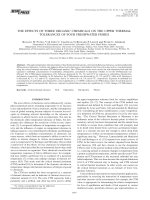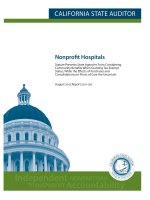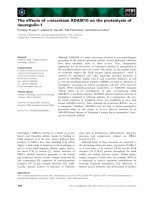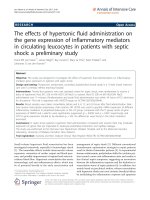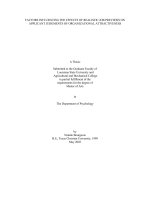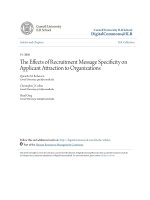Monitoring the effects of Bt maize (Cry1Ab) on non-target organisms pot
Bạn đang xem bản rút gọn của tài liệu. Xem và tải ngay bản đầy đủ của tài liệu tại đây (85.26 KB, 4 trang )
Monitoring the effects of Bt maize (Cry1Ab) on non-target organisms
hp://www.gmo-safety.eu/database/998.monitoring-eects-maize-cry1ab-non-target-organisms.html
(2005 – 2007) Federal Biological Research Centre for Agriculture and Forestry (BBA) (since
2008 Julius Kühn Institute (JKI)), Institute for Integrated Plant Protection, Kleinmachnow
TOP IC
Bt maize is expected to account for part of the maize acreage in Oderbruch when such
varieties are authorised because of the high rate ofEuropean corn borer infestation. Based
on data for the years 2000-2004, impacts of Bt maize cultivation on ecological structures, in
particulararthropod communities in maize fields and field edge biotopes, cannot be ruled
out. Potential impacts are to be monitored in a long-term monitoring programme.
The aim of this project is therefore to develop and test a programme for monitoring the
impacts of large-scale cultivation of Bt maize (Cry1Ab) on the incidence of arthropods and
birds compared to the cultivation of conventional maize. At the end of the project, the aim
is to present a universally applicable labour-unintensive monitoring plan for non-target
organisms.
EXPER I MENT DESCRIPT ION
Example of a field-to-field comparison (with additional insecticide application) BT = Bt maize, KV =
conventional variety (isogenic variety), IN = insecticide application
The experiments are being conducted on five representative sites in Oderbruch, each with
three maize fields (Bt maize, conventional maize with and without insecticide application).
In each case, the conventional variety studied will be the respective isogenic strain. The
fields are to have comparable cultivation conditions and similar infestation pressure from
the European corn borer.
To test the monitoring programme, both the target organism, the European corn borer
(Ostrinia nubilalis), and a number of non-target organisms (bioindicators) are being
observed and are to be surveyed at all sites and on every field.
The following non-target organisms surveyed in the years 2000-2004 are being observed:
aphids, aphid predators such as ladybirds, hover flies, lacewings, ground beetles,
heteropterans, spiders and thrips.
The project is based on ecological status assessment data from 2000 to 2004.
Assessment of the European corn borer
The European corn borer (Ostrinia nubilalis), as the target organism, will be assessed just
before harvesting. The number of European corn borer larvae on every tenth plant
(including ears) of the non-transgenic variants will be counted and the damage to the plants
will be assessed.
No larvae will be assessed on the Bt plots, since a maximum infestation of 0.02 larvae per
plant can be expected due to varietal impurity of around 2 percent.
Assessment of non-target organisms
Maize plants: Three maize plants from five sampling points per maize variant located at
intervals of twenty metres will be searched for non-target organisms. Flowering time proved
to be the optimum time for assessment, therefore assessment will take place only once at
flowering time in subsequent years.
Insects that cannot be identified in the field are collected and identified in the laboratory.
Caterpillars are raised in the laboratory so that they can be classified from the adult
butterflies and moths.
Pit traps: To survey spiders and ground beetles, six pit traps were set up per variant at
distances of twenty metres. They were emptied once a week in July. Spiders and ground
beetles are assessed in terms of quantity and quality.
Assessment of birds
The wetlands beside the river Oder provide a resting place for countless bird species.
Farmland and grassland are used as feeding habitats. The resting behaviour on the different
maize variants is monitored by observing the birds shortly after harvest.
Definition of "corridors of good ecological status"
The data for the individual organisms is used to calculate ‘corridors of good ecological
status’. The actual status is taken from data from conventional maize fields without
insecticide application for the previous five research years. The ‘corridor’ is adapted to the
new data after every season. If a value is significantly outside the corridor, further
investigations are necessary.
Ecological status assessment using baselines
Post-market monitoring which uses this ‘corridor’ should draw on the current reference
variant (conventionally cultivated maize) for a season-specific comparison in order to
interpret variations in the Bt field. The corridor will need to be modified at the end of each
season.
RESULTS
Assessment of the European corn borer
In 2005 and 2006, European corn borer infestation on the five fields varied widely, with
infestation in 2006 generally being very low. The majority of the larvae were found in the
stems of the maize plants. Despite relatively high infestation in some areas in 2005, no
greater damage was found in the field. In most cases, only the upper parts of the plants
showed slight damage. The chemical control proved to be effective.
Assessment of non-target organisms
Maize plants: The data for thrips, heteropterans, aphids and aphid predators are from the
2005 and 2006 flowering periods:
On one of the five fields significantly more thrips occurred on the Bt plot than on the
control plot. Looking at all five fields, more thrips were found on the Bt plot on average.
However, this difference was not significant.It is not possible to carry out precise
identification of the heteropterans in the field, so in 2006 heteropterans were taken to the
laboratory for more detailed identification.
However, there were no significant differences in the occurrence of heteropterans between
the Bt and conventional plots within individual locations. On average for all the fields, a
higher density of heteropterans was found on the Bt plot than on the control plot during the
flowering period.
There were slight differences in aphid numbers between the different sites. In 2006 only
very low numbers were found on the trial sites at flowering time. This could have been
because of the very dry weather and the consequent drought damage to the maize plants,
but also because the flowering period was missed by about a week. There were no
significant differences in aphid numbers between the Bt and control plots within individual
fields.
The predators varied in numbers between the five fields. In line with the low numbers of
aphids in 2006, there were few predators that year. In 2006 there were no significant
differences in predator numbers between the Bt plots and the control plots. In 2005 there
had been significant differences between the Bt and control plots on two fields. A
comparison of the average numbers for all five fields shows that there were not significantly
more predators on the Bt plot than on the control plot.
Pit traps: A total of 12,962 ground beetles were recorded on the five fields in Oderbruch.
7,879 of them were found on the Bt plots and 5,083 on the control plots. With the exception
of one field, more ground beetles per trap and per week were found on the Bt plot.
However, this was not statistically significant.The ground beetles have not yet been
identified down to species level, and the spiders are still awaiting quantitative and
qualitative assessment.
Assessment of birds
There are no indications that the spatial distribution of birds on the trial sites has been
affected by the maize varieties grown. The critical factors which influence the choice of
feeding and resting areas are biotope structures, supply of food and disturbance factors.
Rows of trees and hedges appeared to act as guides for small migratory birds. Stubble
fields, which harbour numerous field mice, had a positive impact on the number and species
spectrum of birds of prey.


